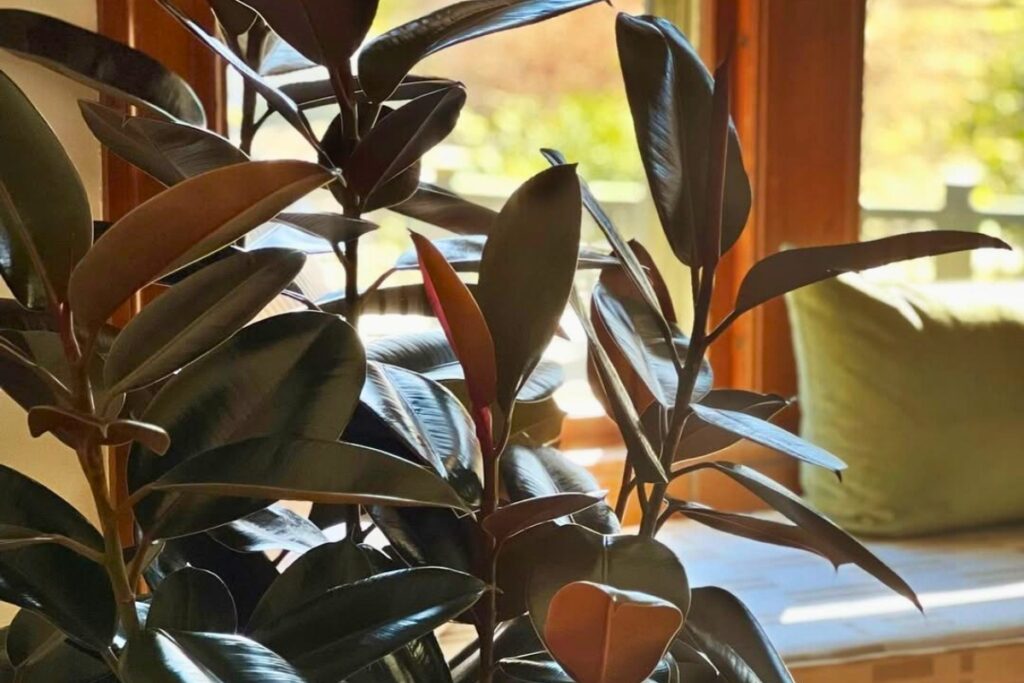Did you know that rubber plants can grow up to 100 feet tall in their native Southeast Asian habitats? While your indoor rubber plant won’t reach these towering heights, you’ll still need to master some essential care techniques to help it thrive. As one of the most adaptable houseplants, your rubber plant can become a stunning focal point in your home – that is, if you understand the key factors that influence its growth and development. Let’s explore how to keep your green companion flourishing.

Contents
Light Requirements and Optimal Placement
Rubber plants (Ficus elastica) thrive in bright, indirect light but can tolerate moderate light conditions. The ideal location provides filtered sunlight, such as near an east-facing window or a few feet away from a south or west-facing window with a sheer curtain. Direct sunlight can scorch the leaves, while insufficient light causes leggy growth and leaf drop.
For best placement, position rubber plants where they receive 6-8 hours of indirect light daily. Indoor locations away from heating vents and cold drafts work best. Rotating the plant quarterly guarantees even growth, as rubber plants naturally grow toward light sources. In offices or rooms with limited natural light, supplemental growing lights can help maintain healthy growth patterns.
Watering Schedule and Humidity Needs
Rubber plants prefer consistent moisture but are susceptible to root rot if overwatered. Water thoroughly when the top 1-2 inches of soil feels dry to the touch, typically every 7-10 days during growing season and less frequently in winter. Allow excess water to drain completely and never let the plant sit in standing water. During hot summer months, the plant may need more frequent watering, while in winter, reduce watering to prevent soggy soil.
These tropical plants thrive in moderate to high humidity levels, ideally between 40-60%. In typical indoor environments, especially during winter when heating systems can dry out the air, additional humidity measures may be necessary. Methods to increase humidity include using a humidity tray filled with pebbles and water, grouping plants together, or running a humidifier nearby. Regular misting of the leaves can also help, but shouldn’t be relied upon as the sole source of humidity.
Soil Selection and Fertilizing Guidelines
Rubber plants thrive in well-draining, rich potting soil with a pH between 6.0 and 7.0. A suitable mix consists of regular potting soil combined with perlite or bark chips to improve drainage and prevent root rot. The soil should retain enough moisture to keep the plant hydrated while allowing excess water to flow freely through the drainage holes.
Fertilizing rubber plants requires a balanced approach during the growing season (spring and summer). Apply a balanced, water-soluble fertilizer (10-10-10 or 20-20-20) once a month during this period. Reduce fertilization during fall and winter when growth naturally slows down. Over-fertilizing can lead to leaf burn and salt buildup in the soil, so it’s better to slightly under-fertilize than to apply too much.
Pruning and Growth Management
Pruning rubber plants (Ficus elastica) helps maintain their shape, size, and overall health while promoting bushier growth. The best time to prune is during the growing season, typically spring or early summer. Remove any dead, damaged, or crossing branches first, then trim back overly long stems to encourage branching. Make clean cuts just above a leaf node at a 45-degree angle to prevent water accumulation and disease.
Growth management also involves pinching out the growing tips of young plants to encourage fuller, more compact growth. For larger rubber plants that have become too tall, more dramatic pruning can be performed by cutting back the main stem to the desired height. The removed stem sections can be propagated to create new plants. After any significant pruning, reduce watering slightly until new growth appears, as the plant will require less water with reduced foliage.
Common Issues and Solutions
Common issues with rubber plants typically include leaf yellowing, leaf drop, brown spots, and stunted growth. Yellowing leaves often indicate overwatering or poor drainage, while leaf drop can occur due to sudden temperature changes or insufficient light. Brown spots may develop from either overwatering or underwatering, as well as exposure to direct sunlight that burns the leaves.
Root rot, pest infestations, and leaf curling are additional problems that rubber plant owners might encounter. Root rot develops in consistently wet soil conditions and can be prevented by ensuring proper drainage and allowing the soil to dry between waterings. Common pests like spider mites, mealybugs, and scale insects can be treated with insecticidal soap or neem oil. Leaf curling usually results from improper watering, low humidity, or temperature stress.
